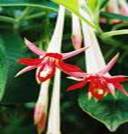| Kingdom | Plantae |
| Division | Magnoliophyta |
| Class | Magnoliopida |
| Order | Myrtales |
| Family | Onagraceae |
| Genus | Fuchsia |
| Species | F. boliviana |
| Binomial name | Fuchsia boliviana |
Other Common Names:
The other common names for the shrub Fuchsia boliviana is fuchsia.
History
Fuchsias originate from South America, growing wild there and in New Zealand. They were first imported into Britain around 1789. During the late 1800s, hybridising of Fuchsias reached its height, when the plants were highly valued by the Victorians. Their popularity after Victorian times declined only to begin another revival from the 1950s until the present time. Many of the original Fuchsia varieties are still popular today.

Description
Medium sized tree to 15-25ft. Growth is in a spreading, somewhat shrubby habit. Although they look very exotic, the fuchsia flower is no different in structure to other flowers. The flower is held by a thin stalk which swells out to form the seed case (ovary). The seed case develops into a tube formed by four sepals. When the flower is only a bud, the sepals are closed. As the flower bursts open, the sepal's part and curl upward. Red (or sometimes white) trumpet-like flowers in hanging, terminal clusters, followed by cylindrical dark-purple berries.


Range
Original Fuchsia species can be found particularly in Central and South America, usually in mountainous areas or on the edge of rainforests. The great majority are native to South America, but with a few occurring north through Central America to Mexico, and also several from New Zealand, and Tahiti.
Habitat
Grows quite well in shady or part-sun environments, as well as foggy areas. Bolivian Fuchsia also thrives in cooler, subtropical-like environments. Protect from direct sun, and temperatures exceeding 105F.It is found in track and stream sides, forest margins, disturbed and intact forest.
Cultivation
Fuchsias appreciate well-dug fertile soil that does not dry out, but is not water-logged. All varieties of soil suit them as long as these conditions can be met by extra watering and/or feeding where they are not naturally present. Dig in as much organic matter as possible before planting to increases drainage and fertility. A generous couple of handfuls of bonemeal (per square metre / yard) should be incorporated into the soil when digging to increase it's fertility throughout the season ahead. Seed are best sown as soon as it is ripe though it can also be sown in the spring. Surface sow the seed in pots in a warm greenhouse and do not allow the compost to dry out. Germination should take place in less than 6 weeks. Prick out the seedlings into individual pots when they are large enough to handle, and grow them on in the greenhouse for at least their first winter. Plant out in late spring or early summer, after the last expected frosts. Inter-nodal cuttings of greenwood, 5 - 8cm long, May/June in a frame. Cuttings usually succeed at any time during the growing season.
Flowering Season
The flowers which include singles, semi-doubles and doubles, and can be upward or outward facing are in bloom from June through September. But however flowers are borne in clumps, and cover the tree for most of the year.
Pests and Diseases
Look for attacks of whitefly or greenfly. The bugs can either be squashed manually or treated with a proprietary spray.Fuchsias are eaten by the caterpillars of some Lepidoptera, such as the Elephant Hawk-moth.
Parts Used

The fruits and the flowers are the most commonly used parts of the plant both for its medicinal and commercial applications.
Medicinal Applications
• Though it is of commercial importance for its decorative purposes it is not known for its medicinal values.
Commercial Applications
• Fuchsias add colour to borders, pots and hanging baskets.
• Fruits are eaten raw, but the plant is most commonly grown for its ornamental flowers.
• Excellent jam can be made from the berries of some varieties.

According to flower folklore, the fuchsia symbolizes a warning. So after you've hung up your blooming basket in a nice shady spot, you could enchant it for protection. They are also used in charms and spells to speed things up. The colour of the flower is matched up according to the magical intentions which are believed to spread energy and excitement into life. In the cold weather cover these plants with a mulch of bracken - they seem to like each other; some people dig in shoots of young bracken when fuchsias are being planted.